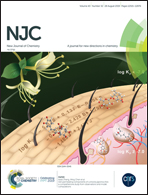Exploring the effects of axial halogen substitutions of boron subphthalocyanines on the performance of BsubPC/C60 organic solar cells: a DFT/TDDFT-based computational study†
Abstract
Organic solar cells based on small organic molecules have some unique advantages. Non-planar small-molecule boron subphthalocyanine chloride, one of the promising materials of organic solar cells, has attracted global researchers. The axial substitutions of subphthalocyanine show noticeable influences on their photoelectrical properties. In this paper, we systematically study the effects of axial halogen (F, Cl, Br) substitutions of chlorine atoms on the optical and physical properties of subphthalocyanine/C60 solar cells by combining a DFT/TDDFT study and the available experimental data of X-subPC/C60 (X = F, Cl) solar cells. Two favorable configurations (umbrella/bed: C60 in/on the concave/convex of subphthalocyanine, respectively) at the heterointerface of the solar cell are modeled. By utilizing long range corrected density functionals and the polarizable continuum model, we find that the wavelengths of the absorption peaks and the calculated open circuit voltages of the subphthalocyanine/C60 series slightly increase from fluorine to chlorine to bromine substitution. The latter has the same trend as the calculated first charge transfer states of TDDFT. Furthermore, interestingly, the computed data demonstrate that both F-BsubPC/C60 configurations have the smallest exciton binding energy among these bi-molecular systems, though the exciton binding energy of the F-BsubPC monomer is larger than that of X-BsubPC (X = Cl, Br).



 Please wait while we load your content...
Please wait while we load your content...